How to Choose the Right Kayak [Ultimate Guide 2020]
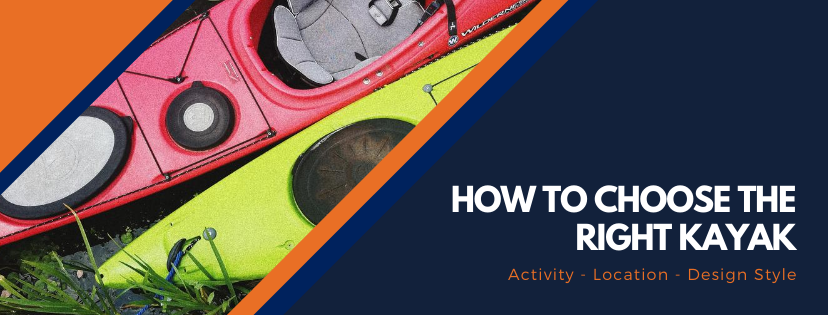
Kayaking is an excellent way to explore the outdoors and see new sights. Rivers, open water, the sea, lakes, bays, and more are all unlimited with the proper kayak and can grant beautiful journeys with unique experiences. Kayaks are designed in various makes and models to fit every adventurer, from the relaxing recreational paddler to the open-ocean fisherman. So how do you know which kayak is the right fit for you and what you want to do and where you want to go?
Small ponds, whitewater rivers, choppy ocean waves, and all other bodies of water have different elements that affect a kayak’s mobility and balance, which is why kayaks are designed in various widths, sizes, and models so that every kayaker has the vessel to fit their needs. Taking into consideration everything from width to size to speed, we break down the recommended kayaks based on where you want to go kayaking and what you want to do. This is our ultimate kayak purchasing guide to help you understand what your needs are and what kayak will take you where you want to go, so all you have to do is sit back and paddle (or pedal) as you enjoy the ride.
From the seasoned kayaker looking to branch out, to the new kayaker making their first purchase, this guide will help identify your main goals and pair you with the kayak design that will fit your needs the most.
Table of Contents
Basic Options for Most Kayak Designs
When browsing the different makes and models of kayaks, many designs will have options for you to select from that apply to almost every model of kayak. These can include where you sit, how you get around, your storage components, and more. We’re going to break down these kayak options so you understand what we’re referring to when we mention them, and you can begin to put together an image in your head of what options you would be most comfortable using and what you will need on the water, whether it be pedal-power or plenty of room for fishing equipment.
Sit-On vs Sit-In Kayaks
Most kayak makes and models will allow for the option of a sit-on or a sit-in style, and both have their pros and cons when you are out on the water. It’s important to keep sit-in or sit-on kayak styles in mind, because these affect what seasons and weather you can use your kayak in, your overall balance, safety, and more.
A few immediate considerations to address:
- Paddle Lengths: the length of a paddle used in a sit-in kayak will vary from a sit-on, because your distance from the water changes. Although an adjustable paddle may be a solution if you plan to switch from a sit-in to a sit-on often, it is best to purchase paddles for both types if you plan on using both frequently.
- Both models are stable: the stability of your kayak will not change based on a sit-in or sit-on model, because kayak stability is a result of the width of the kayak, not where the seat is located, and each style is designed with the appropriate width to handle the type of seat you choose.
Sit-On-Top Kayaks
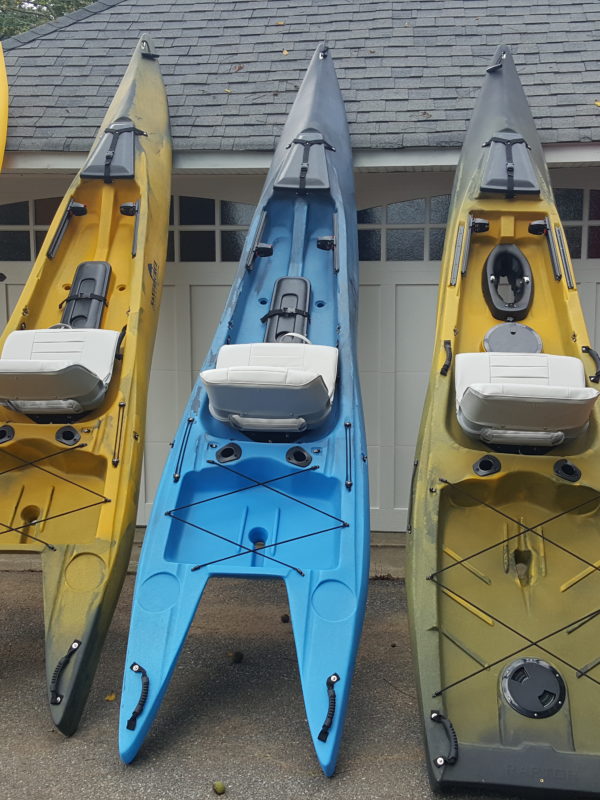
Sit-on kayaks keep you on top of the kayak, as opposed to sitting in the design. Sometimes this involves an actual elevated seat, like in fishing kayaks, but sometimes it simply means you lack the enclosure that is seen with sit-in kayaks, and the kayak will resemble more of a canoe design, allowing your legs to be free.
Sit-On-Top kayaks are recommended for beginners due to their safety aspect — if you were to roll a sit-on-top kayak, it is easy to kick to the top freely, flip the kayak, and remount. Flipping a sit-in kayak requires skill to know how to roll the kayak back to an upright position while your legs and body are still within the kayak, or you would need to learn how to bail out while underwater. For this reason, sit-on-top kayaks are suggested for new kayakers because you don’t need additional training of how to escape in case of a roll — your body and legs are free to swim away from the kayak, to the surface of the water, and roll the kayak.
Sit-on-Top kayaks are advised for ocean or sea use due to this safety aspect of an easy remount, as well. If waves were to suddenly kick-up and surprise even an experienced kayaker, sit-on-tops allow for an easy remount without being caught inside of kayak in waves or choppy water.
Sit-on-top kayaks also are equipped with drain holes – in the case of a roll, they will drain the water so the kayak will not be flooded, and you can paddle back safely to shore without getting weighed down. These models are also easier to launch and mount because you do not have to step into the kayak, simply onto it.
Sit-on-Tops are also the recommended option when fishing. Sit-on-Top fishing kayaks allow for greater mobility and provide an easier time of reeling in fish and managing them once they are on board. Sit-on-Top models also generally provide room for standing and greater stability with a wider design to compensate for the seat position — this allows you to fish with ease standing up instead of being resigned to only sitting. You will also get additional surface space on a sit-on kayak for the fish you catch and your gear.
The downside to a sit-on-top kayak is that it does not protect you from the weather or natural elements. Because you are sitting on top and exposed, you will get wet from splashing water, unexpected rain, or encounter issues with other elements, like sunburn, insects, cold temperatures, etc.
You can purchase sit-on-top kayaks with both higher raised seats and lower seats. Lower seats are likely to have more stability but high-seats are often designed with a larger width to compensate.
Sit-In Kayaks
Sit-in kayaks have the rider placed inside the kayak, where your legs are enclosed from the hips or waist down. You can opt to simply sit in the kayak, or use an additional seal to prevent water from getting into the hole you are sitting in, keeping your legs dry and warm.
Sit-in kayaks are great for longer trips or colder temperatures. There is often a seal that protects you from the water, so you are less likely to get wet and you can stay insulated when traveling during colder seasons.
Sit-in kayaks are also a lighter weight than sit-on kayaks due to the lack of additional hardware for the seat, and therefore can be easier to transport, especially if kayaking solo.
You are more likely to stay dry in a sit-in kayak, and most of these models provide more waterproof storage solutions than sit-on kayaks. These designs are also more likely to have storage in both the front and rear sides of the kayak. The downside, however, is that you will be required to get up and out of the kayak to access these storage areas because they will not be within the range of your reach and you will not have anywhere to stand on the kayak, so you cannot access your belongings while on the water in most situations.
Sit-in kayaks are easier to paddle over long distances because you are closer to the water, reducing the strength needed to push the kayak forward, making them a great option for traveling long lakes or rivers.
The downsides of sit-in kayaks to consider is that they require additional training for how to remove yourself if you incur a roll, wipeout, or capsize. Because your legs are encased within the kayak, sometimes with an additional seal over top, you are not simply able to kick free and swim to the surface of the water if you flip over. You must take safety lessons to learn how to remove yourself and how to roll the kayak while it takes on water.
For these reasons, sit-in kayaks are recommended for use only close to shore and water banks — once they begin to take on water it can be very difficult if not impossible to paddle back to shore safely.
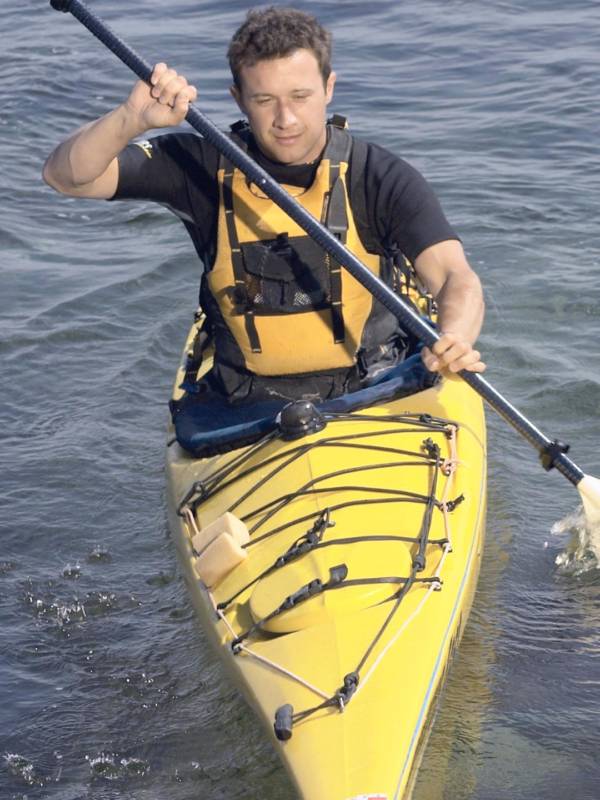
Pedal vs Paddle Kayaks
Another design feature to consider when choosing a kayak is whether you want a kayak you paddle or a kayak you pedal. While you may be more familiar with paddle kayaks, pedal kayak designs can be beneficial in certain circumstances and should be considered for certain uses. Pedal vs paddle kayaks are also an extremely popular consideration when your primary focus is fishing.
Paddle Kayaks
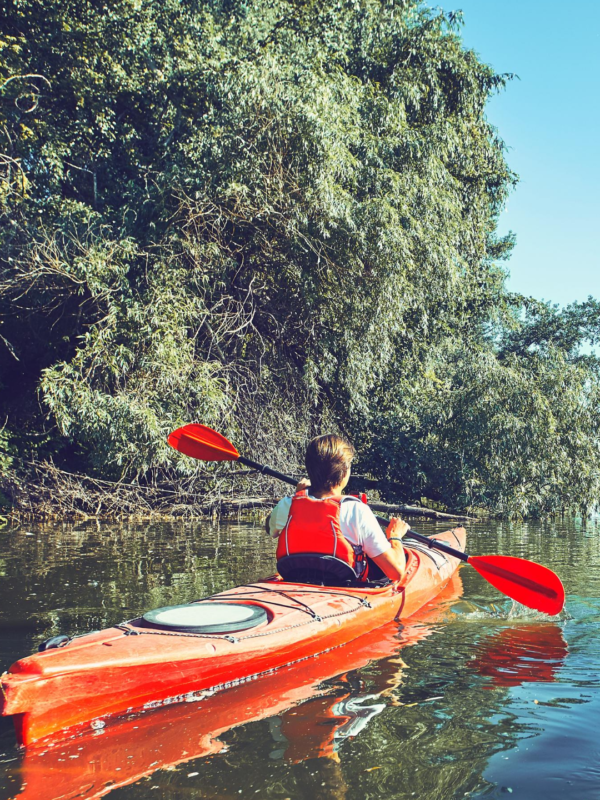
Paddle kayaks are seen as the “traditional” kayaks because this was the original make, model, and intent. Some kayak enthusiasts may argue paddle kayaks are the only way to go, but pedal kayak benefits should not be discounted when making a consideration.
Paddle kayaks are great for fishing kayaks, touring kayaks, and more. This is the primary style you will see across all kayak models. These are cheaper than pedal kayaks because they do not require additional hardware, and therefore are more affordable and accessible.
Some benefits to paddle kayaks include their ability to give you a workout and tone new parts of your body. If you are interested in kayaking as a form of exercise, you will gain arm muscle and endurance with paddle kayaks.
When considering a paddle kayak for fishing, paddle kayak designs allow you to fish in shallower waters, because there is no additional equipment installed on the kayak. Paddle kayaks can also be quieter due to the ability to control the push of the water to propel yourself forward.
The downside to paddle kayaks is that you may not be able to travel as far distances as you would in a pedal kayak — pedal kayaks allow for longer trips because leg muscles and leg endurance has already been built up in most people, versus building arm strength and upper body endurance; even seasoned kayakers will be able to travel further distances with a pedal model. Another consideration is that it can take a while to hone a paddle technique, which can prevent new kayakers from traveling the distances they want until they find their rhythm.
Pedal Kayaks
Pedal kayak designs can feel newer to some kayakers but they have quickly gained popularity in the kayaking community. Pedal kayaks have many pros and can be a beneficial consideration for both experienced kayakers and novices alike.
The pros of a pedal kayak, especially for beginners, is that you do not need to hone your paddle technique to enjoy kayaking. Being new to kayaking, a paddle kayak can require a learning curve with steering, propelling, and more. A pedal kayak is straightforward and provides immediate access to kayaking.
For both season kayakers and new kayakers alike, a pedal kayak allows you to travel further distances and get to your destination faster. Leg endurance is often much stronger than arm endurance for most people starting out, and even in experienced kayakers this can be the case. When kayaking in large bodies of water or intending to go further distances, a pedal kayak can be a great asset.
Pedal kayaks are also extremely popular in fishing kayak models due to their ability to allow you to kayak hands-free. This allows anglers to fish while traveling from place to place, and you do not need to worry about adjusting your rod to a secure position when you wish to move from spot to spot. This is also a great benefit when fishing in large bodies of water where you may wish to move from location to location frequently.
The downside to pedal kayaks is that their additional equipment does not allow them to be in shallow water. This additional equipment also makes pedal kayaks more expensive and can be a larger investment than a paddle kayak.
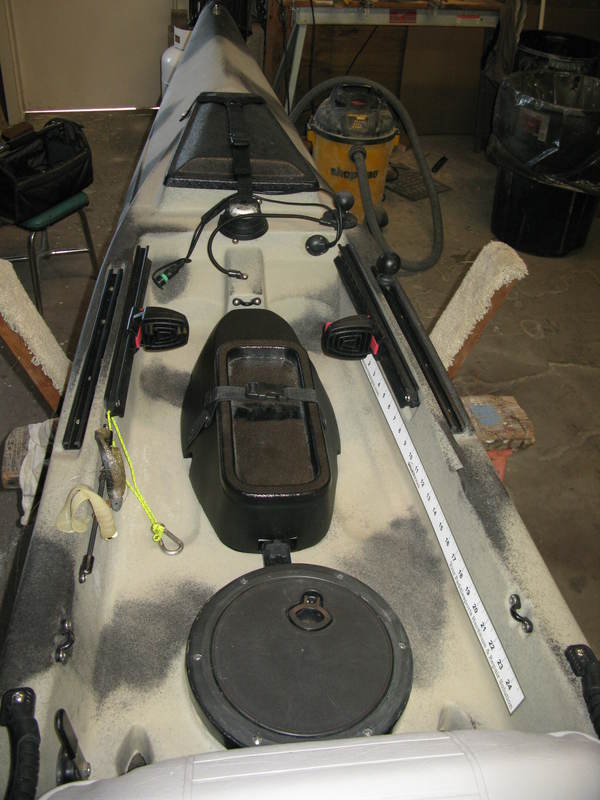
Other Considerations for Your Kayak Purchase
When choosing your kayak, there are other considerations you will need to take into account. While touring kayaks, recreation kayaks, and all other designed kayaks have their general widths, sizes, accessories, and more, these all vary from brand to brand. Take into account these following details when selecting a kayak for purchase, even within each model and design:
Storage On-Board Your Kayak
Not all kayaks are designed with on-board storage in mind. For this reason, it is important to consider the length of your trip, if you need to haul fishing equipment, if you like to have a camera or other items on board, and other storage factors.
Larger kayaks, like touring kayaks, will have more storage solutions, ideal for long day trips or overnight camping excursions. Sit-on-top kayaks generally have a design fitted with an open space to strap a waterproof bag with equipment and an interior storage solution in the front. Sit-ins, by comparison, offer more storage under the decks both in the front and in the rear.
Overall, touring kayaks will offer you the most onboard storage for longer trips, and sit-on-tops may be your best option for storage compartments you need to access while onboard the kayak.
Where to Store Your Kayak
Be sure when searching for your kayak you consider where you will store your kayak when not in use. Although this may feel like something you will work out after the fact, you want to be sure you have a safe place to store the kayak you have invested in.
Along with storing your kayak, consider how you will transport it and how easy it will be to move from the vehicle to the water and back. Longer, touring kayaks will provide more difficulties with storage and transport due to their long length, as opposed to inflatable kayaks that are easy to store and transport but that you must inflate before use.
Don’t wait until after your purchase, consider this while weighing your options before a purchase.
Tandem or Solo
Considering whether you will kayak solo or tandem does not only affect if you purchase a tandem kayak, but can also influence what size kayak you buy based on how easy it is to transport alone.
If you plan on kayaking in an individual kayak but know you will almost always go out on the water with a group, you can invest in a kayak that may require an additional set of hands to transport from the vehicle to the water.
This is a smart consideration because if you plan on mostly going out alone in a fishing kayak or to enjoy some peace and quiet to yourself, you’ll need to be sure you get a kayak you can load and unload yourself.
Sizes and Weights
Longer kayaks will always go faster than shorter kayaks, but shorter kayaks will be easier to turn.
The curve in your kayak, known as the rocker, can affect how easy it is to turn and move, just like the length. A boxier kayak will much more stable, but have less maneuverability. Therefore narrow kayaks move slightly easier to your instruction.
The make and model of your kayak will ultimately determine the size and weight, but you will have some flexibility in most models to find a width and length you’re comfortable both transporting and paddling.
Standard Kayak Designs and Models
It’s important to understand the different designs of kayaks and what options you have when selecting one for purchase. We’ll break down some simple design aspects to help you understand why certain kayaks are recommended for certain activities or locations, to help you feel secure and confident in your next kayak purchase.
Understanding the different types of kayaks before you read the recommendations based on activity and location will help you have a more comprehensive understanding of why these models are suggested. However, if you are well versed in kayak models, or you want to get into the thick of it, you can jump directly to browsing kayaks suggested based on body of water, or kayaks suggested for purchase based on activity. This information will always be here waiting for you!
Keep in mind that every brand, make, and model will vary in details, specs, accessories, and more, but these are the general designs that you can count on and can look for when considering your next purchase. This is a great starting point for finding your perfect kayak match.
The Recreation Kayak
Recreation kayaks are popular models no matter where you are in your kayaking experience; beginner kayakers, casual kayakers, and experienced kayakers can all enjoy a recreation kayak design. If you are new to kayaking, this will be a popular design to consider and probably one of the safest options to start off with.
Recreation kayaks are most notable for their short and wide bodies, which provides stability during use. Recreation kayaks have wider cockpit designs, which are roomier and often more comfortable, especially for beginners choosing a sit-in style. Recreation kayaks provide a small amount of storage in most models, often in the form of a single stash location. They are not generally equipped with enough storage for a longer or multi-day trip, however.
Maneuverability is a benefit of recreation kayaks due to their design (short and wide), but this comes at the price of the recreation kayak being unable to maintain a straight line when coasting. Therefore, paddling a recreation kayak requires frequent corrections to stay on course. Due to their shorter length, recreation kayaks are often the easiest to transport, especially when going out solo.
Best Bodies of Water to Take a Recreation Kayak:
Small to medium calm lakes, slow running rivers, flat-water bays, and bodies of water sheltered from extreme winds or waves are the best locations to take recreation kayaks. These do not fair well in choppy or unpredictable water.
Recommended Activities:
Fishing, day trips, exercise, or calm-water sightseeing.
Options for a Recreation Kayak
- Inflatable Models
- Tandem
- Sit-In or Sit-On-Top
- Pedal Design Available
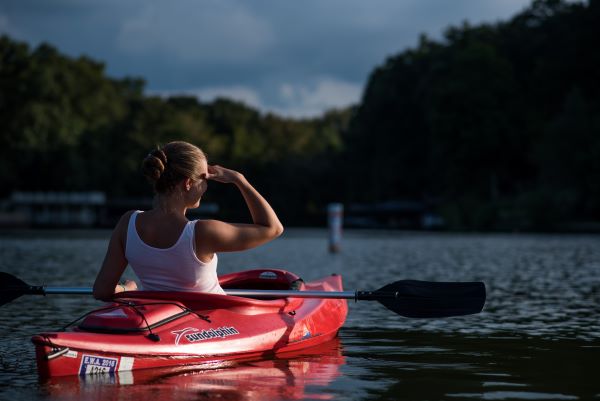
Inflatable Kayak
Inflatable kayaks are most often designed as recreation models, although they do have variations for other activities, including whitewater adventuring. Inflatable kayaks are designed with rivers, natural elements, lakes, and other factors in mind, so they can handle bump-ins with rocks and other natural-elements without puncturing.
Although sturdy, if an inflatable kayak receives a puncture it can render it useless and is difficult to patch. These are not recommended for longer trips but are great for beginners, families, and children. Inflatable kayaks are also the best design to opt for when facing storage solutions, because they are more compact and able to be packed with ease. If are living in an apartment, condo, RV, or other limited capacity location, an inflatable kayak will allow you to explore the open water without having to find the storage space back home. The downside to an inflatable kayak is the time it takes to inflate and deflate before and after use.
Inflatable kayaks are best used in the same scenarios as recreation kayaks:
Calmer, slow-moving waters, avoid harsh weather, and stay close to shorelines. Day trips, sight-seeing, exercise, and family outings are great activities to use an inflatable kayak for.
Options for an Inflatable Kayak
- Tandem
- Sit-In or Sit-On-Top
- Pedal Design Available
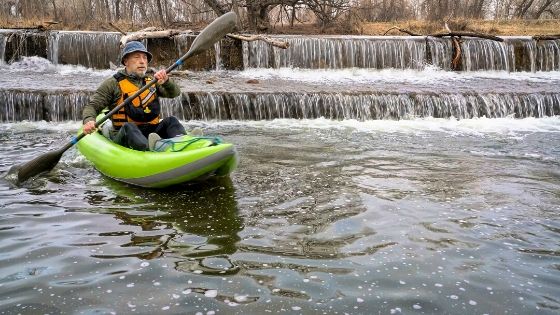
Touring Kayak
Compared to recreation kayaks, touring kayaks are longer, narrower, and equipped with more storage options for equipment. They come in a variety of lengths with various intentions for each model — there are touring kayaks intended solely for day trips, some for a weekend or a few days, and models designed for longer trips surpassing a simple weekend. Some touring kayaks are referred to as “sea kayaks” due to their ability to handle rougher waters, travel long distances, and keep the kayaker protected from the elements. Their storage capacity allows for a few days’ supplies to be kept on board for camping adventures or other long trips. These storage options, however, reduce the size of the cockpit, making them less roomy than a traditional recreation kayak.
Because of their length and narrower body, touring kayaks move at a faster speed than recreation kayaks and keep a straight-line path with ease. They are harder to turn, however, and are unsuitable for rivers that have frequent bends or curves as part of the navigation. Some touring kayaks can be purchased as an inflatable model, but these should be considered by an experienced kayaker and not relied on for long trips surpassing a simple overnight adventure.
Touring kayaks allow for either a sit-in or sit-on-top model, but touring kayaks intended for longer trips will be a sit-in model only, requiring proper safety instruction before use on how to exit the kayak should it flip while in use. The sit-in design protects the kayaker from the elements while out on the water and traveling for several days.
Touring kayaks can be harder to store when not in use due to their length and may require an additional set of hands during transport, so consider if you have the room to store your kayak safely when not in use, and if you are able to transport it alone.
Touring Kayaks are Great for:
Larger lakes, longer rivers, or experienced kayakers to take out on open bodies of water away from shore.
Options for a Touring Kayak
- Inflatable Designs
- Tandem
- Sit-In or Sit-On-Top
- Pedal Design Available
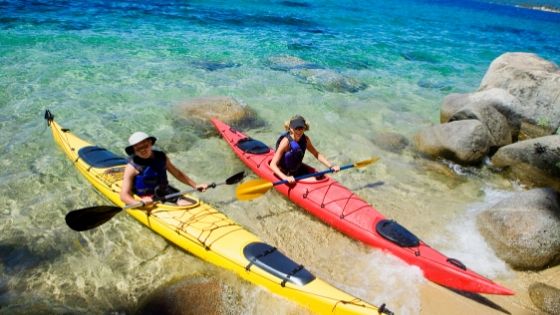
Whitewater Kayak
If adventurous water is what you are seeking, then a whitewater kayak is going to be the kayak you want — recommended only for experienced kayakers and not beginners. If you are a beginner and interested in whitewater kayaking, seek out your local tour guides or whitewater experienced guided trips who will help instruct you in safety, basic kayaking skills, and more to help get you to a level needed for these excursions.
Whitewater kayaks also come in various sub-designs depending on what type of whitewater you want to navigate — there are playboards intended for jumps and tricks, and long narrower models meant for cutting through the whitewater.
We won’t cover all over these, as whitewater kayaking is definitely an experience unto its self. It is important to note that whitewater kayaks are inherently unstable in order to navigate choppy waters, do not move quickly in calm waters, lack in comfort or roomy cockpits, and do not have storage space. Therefore, a whitewater kayak should only be purchased for its intended purpose, and not be purchased or relied on for other types of kayaking, otherwise, your kayaking experience may be slower, unstable, and more awkward than intended.
Options for a Whitewater Kayak
- Inflatable Designs
- Tandem
- Sit-In or Sit-On-Top
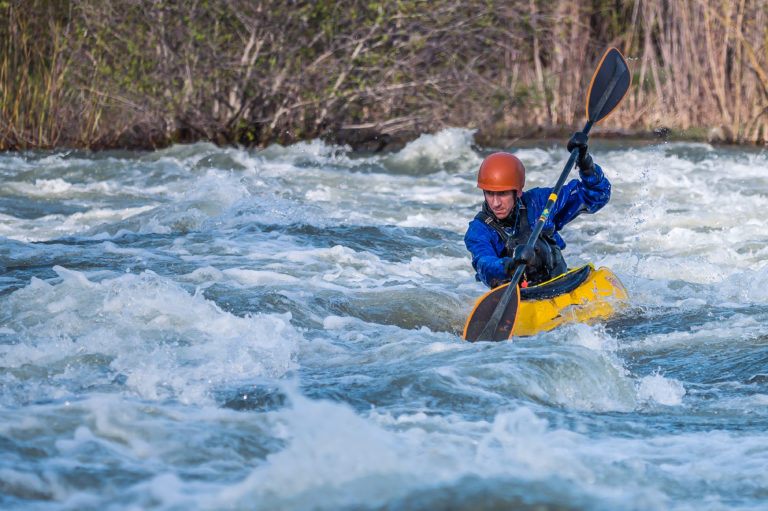
Fishing Kayak
Fishing kayaks are designed specifically for the fisherman in mind and can accommodate various bodies of water, depending on where you like to do your fishing.
Fishing kayaks are wider than other kayaks, to provide optimal stability and they even allow for standing onboard the kayak. They come in paddle or pedal models, so you can free up for your hands to pedal the water while still maintaining free hands for rods, nets, or other equipment.
The benefits of fishing kayaks over a recreation or touring kayak to do your fishing is that the on-board storage, balance, and seating are all optimized around a successful fishing experience, and these models already come equipped with the majority of accessories you will need to begin fishing from the cockpit right away; touring or recreation kayaks that you intend to use for fishing will have additional purchases required in order to get the fishing attachments you need.
Options for a Fishing Kayak
- Sit-In or Sit-On-Top
- Pedal Design Available
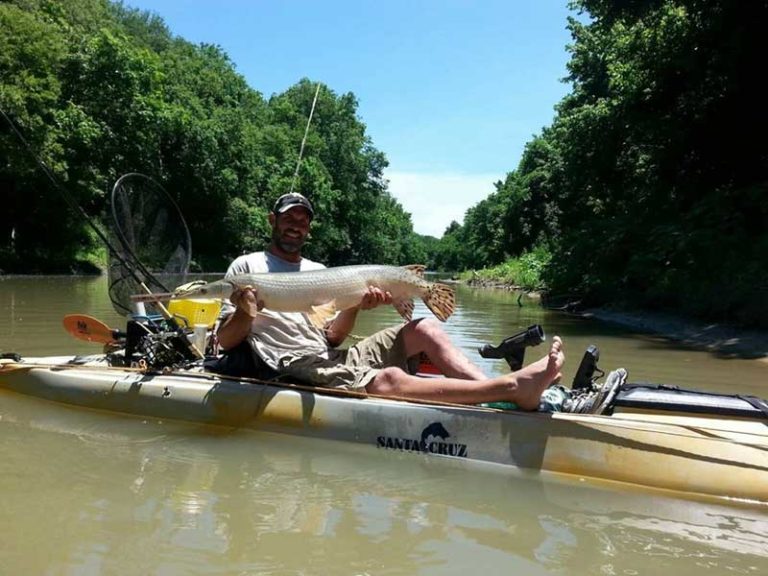
Tandem Kayak
If taking to the water solo is not your cup-of-tea, tandem kayaks are great for couples, families, or best friends who like to share a boat. Tandem kayaks come in inflatable options, recreation styles, and some touring models. It is important to note that tandem kayaks often cannot be used solo, so if you ever want to go out on your own and all you have is a tandem kayak, you will not fair too well. This is due to the length of the kayak, the weight, and the seats being proportioned out so they are no longer in the center. That said, these designs are great for families so you do not need to worry about being separated in two separate kayaks and work great with kids.
Most tandem kayaks will require synchronized paddling, due to the lengths of the paddles — if you are not in sync with your partner, your paddles may clash. Some tandem kayaks, however, space the seats far enough apart that this is not an issue, but the majority of the time you will want to make sure you both find the same rhythm and can keep a similar pace.
Keep in mind that tandem kayaks can be difficult to adapt to if you already have an experienced kayaking style — discuss kayaking styles and intentions with your partner before purchasing a tandem kayak together. For instance, if you like to take your time and take in the sights, but your partner’s intent is to paddle right through to the destination, you will have conflicting habits when kayaking together in tandem, which is something to figure out before and not after you make an investment.
Beginners fare very well in tandem kayaks, however, because it allows them different intervals to take a break, to learn from someone more experienced, and share the adventure. If you’re a beginner, it is recommended to only purchase a tandem kayak if you have someone experienced to help show you the ropes who has dedicated the time to assist you.
Options for a Tandem Kayak
- Sit-In or Sit-On-Top
- Pedal Design Available
- Inflatable Designs
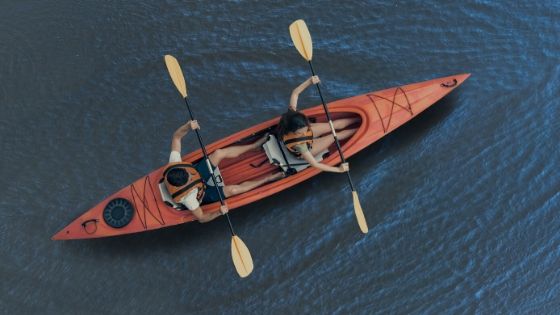
Location: Choosing a Kayak for Where You’re Going
One of the easiest ways to hone in on the right type of kayak is to think about where you plan on going kayaking the most. A lot of kayak models will be applicable for lakes and rivers, or oceans and bays, but the kayak you will want to use for fishing in the sea will not be the kayak you use to go whitewater rafting.
We’ve broken down some of the main areas you may consider taking your kayak, and what designs are the best suited for those locations. If you’d rather, we’ve also broken down kayak recommendations based on what you plan on doing, not necessarily where. Either combination of recommendations will provide you with a base starting point for discovering your best vessel!
Lake Kayaking
Lakes, both large and small, are great places for kayaking. Lakes offer recreation kayaking, fishing, exercising with paddles or with pedals, solo and tandem trips, and in some cases, weekend or overnight trips.
Kayaking on a lake is recommended for beginners and experts alike because lakes provide a wide variety of kayaking activities and keep you close to shore, and are generally considered calm water unless disrupted by bad weather.
The intensity of kayaking on a lake varies with the size of the lake and the weather you encounter. Smaller lakes will almost always provide a calm, relaxing kayaking experience and are good for a day’s ride. Larger lakes, however, can be more intense based on the weather. Strong winds can impact a large lake, creating choppy water and a rougher ride. Some lakes are so large you may even be able to do a weekend trip around the lake, instead of just one day on the water.
Keep in mind the size of your lake, how far from shore you’ll be during your travels, if you wish to do an overnight trip, if you plan on fishing or exercising, and if you want to go alone or with friends and family when selecting the right kayak model for these types of trips.
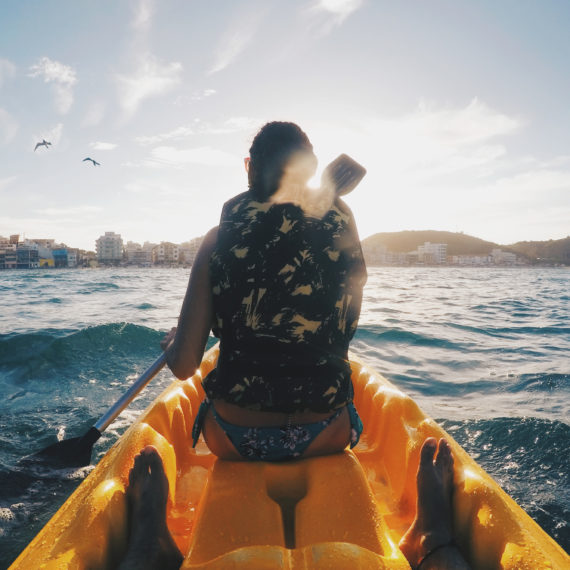
Recommended Kayak Models for Lake Adventures:
General Recreation Kayaks
Inflatable Kayaks
Inflatable kayaks are another version of recreation kayaks, without having to worry about storage. Inflatable kayaks work great on lakes because the water is calm and there’s not a lot of interference from natural elements. These are great for kids and new kayakers alike.
Tandem Kayaks
If you prefer to go out on the water in a pair, tandem kayaks on a lake are the perfect experience. Tandem kayaks hold two people and therefore have two people paddling, so you don’t have to go it alone. Because lake kayaking is most often only a day’s worth of boating and is used for relaxation, fishing, or exercise, having company in a tandem kayak is the perfect lake experience.
Fishing Kayaks
If your primary reason for being out on the lake is fishing, a fishing kayak is highly recommended. Fishing kayaks are an upgrade from a standard kayak because their design takes into account extra gear, fish storage, stability, and more. A pedal fishing kayak is the perfect design for being out on the lake if your intent is to spend the time fishing because you can move quickly, be hands-free, and have plenty of onboard space for your gear and the fish you catch.
Touring Kayaks
Although not suitable for smaller lakes, larger lakes can sometimes demand or accommodate a touring kayak. Touring kayaks are longer and narrower, which means they go faster than recreation kayaks and are the perfect transport if you want to take a trip for a couple of days. These have more storage compartments for gear, which a larger lake may demand if you plan on camping overnight. Do not use these on small lakes, however, as you may cut your trip short from having traveled too quickly from one side to the next, and they’re not very roomy for beginners.
River Kayaking
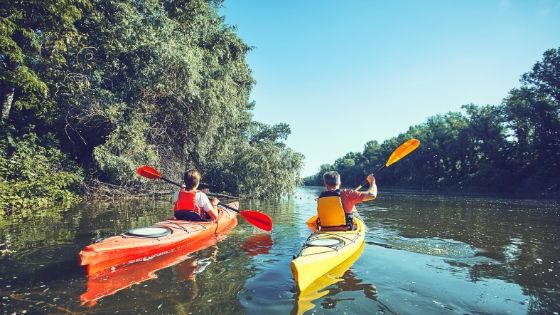
Kayaks used on rivers can be similar to the models used on lakes, but there are a few more factors to consider when making your purchase. Take into account the length of the rivers you visit and how large or wide they are.
While some rivers can be very calm, similar to lakes, some have strong undercurrents that will affect how your kayak behaves. If you are an adventurous type and want to go into whitewater, you will need to be especially considerate of what river kayak you purchase.
Recommended Kayak Models for River Adventures:
General Recreation Kayaks
General recreation kayaks are still a great option for calm river kayaking, especially for day trips. If you’re on a lazy river or one without a lot of strong currents, this is a great pick for beginners, experienced kayakers, and families. The width of a general recreation kayak will keep you stable during your river kayaking experience so you can sit back and enjoy the ride.
Inflatable Kayaks
Whitewater Kayaks
If whitewater adventures are what you are seeking when river kayaking, then a whitewater kayak is the purchase you should invest in. Whitewater kayaks have their own different models and designs to choose from, but the general build is always quite different from a recreation, touring, or fishing kayak. We won’t break down each make of a whitewater kayak, but they are generally either much shorter or extremely long and narrow to handle the type of whitewater river experience you intend to have.
Fishing Kayaks
A river can be a great place to float along and cast out your fishing line. Fishing kayaks have the storage for fishing gear, lines, and fish storage. These are also much more stable to allow for an easy reel-in. Not all fishing kayaks can handle the undercurrents of a river, so be sure to think about what rivers you will frequent the most often and see if the width of your fishing kayak is a good match. Pedal fishing kayaks will also not be able to handle shallow water, so research the depth of the river you want to kayak on for each season or weather condition to avoid any issues.
Touring Kayaks
Rivers can provide great multi-day or weekend trips on a kayak, and that is when we recommend a touring kayak. Touring kayaks are longer and narrower than general recreation kayaks, which allows them to have increased speed. Touring kayaks also allow for greater control when turning and come with larger storage areas so you can bring all of your camping gear for an overnight experience. Touring kayaks can be more difficult to turn, so make sure you are prepared for however many bends your river supplies you with.
Seas, Bays, and Ocean Kayaking
Kayaking out on the open sea or ocean is the perfect opportunity to take in a new adventure away from home. Open water allows for recreational kayaking, fishing, exercising, day trips or longer adventures, which means depending on what your plan is when kayaking in the ocean affects which kayak purchase is best for you.
Weather is an important factor to keep in mind when purchasing a kayak for use in the sea or ocean. If you are in a location or going to be kayaking in a location with extreme weather, strong winds and other elements can affect your kayaking experience.
The further you get from the coast can also create a choppier kayaking experience, so always plan ahead and consider what ocean water levels you’ve encountered or plan to encounter. In general, we always recommend a sit-on-top kayak for these large bodies of water, so in case of capsizing or flipping, extracting yourself from the kayak will not be a safety issue.
Bays are similar to oceans and the sea because the weather can affect the waves and tides. However, flat-water bays are likely to be a calmer experience, and you can often opt for a general recreation kayak if you are mindful of the weather when visiting.
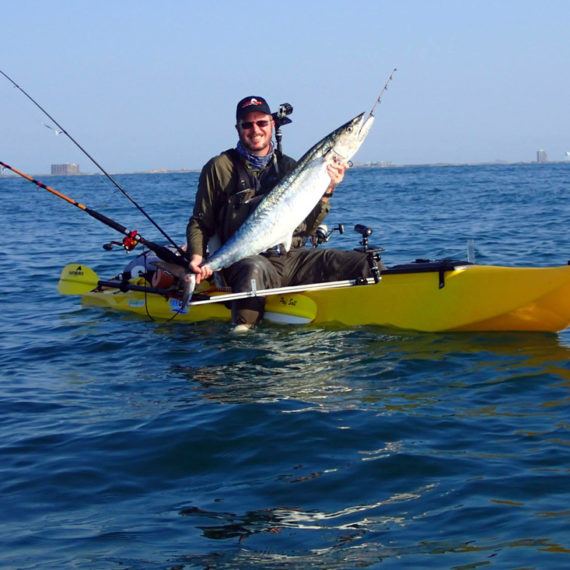
Recommended Kayak Models for Open Water Adventures:
General Recreation Kayaks
A general recreation kayak can be a good option for kayaking in the sea or ocean if you don’t plan to go too far from shore. These won’t get you anywhere very fast, but will still allow for a casual kayaking experience near the waterline.
Fishing Kayaks
A sit-on-top pedal fishing kayak can not be beaten when taking to the ocean for some fishing action. Pedal fishing kayaks allow you to cover more ground and reach your fishing location with ease, and you can travel from one spot to the next hands free so your rod can always stay out and active. A fishing kayak is the best option if fishing is your primary activity on the sea because it will come equipped with all the storage solutions and working room you need.
Touring Kayaks
If your intent is to go further out in the ocean or travel long distances while on the water, a touring kayak is highly recommended. These are intended for you to travel more miles at a faster speed, so you can get to your destination or cover more ground for sight-seeing. Touring kayaks may also be easier to use on large bodies of water versus rivers or other restricted areas because they do not turn easily and the sea and ocean will not require sharp turns.
Tandem Kayaks
Whitewater Kayaking
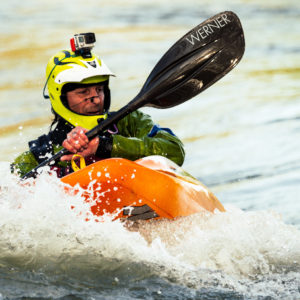
If adventurous whitewater is more of your interest, there are specific whitewater designed kayaks. These range from play whitewater kayaks to longer whitewater kayaks made to cut through harsh currents quickly, while the shorter play whitewater kayaks are designed for tricks and jumps.
We don’t go into each whitewater specific description, but your local whitewater kayak guide can help you decide; we don’t recommend these for beginners until you have mastered general kayaking, and even then you should work with someone experienced to stay safe.
Activity: Choose a Kayak Based on Your Interest
Where you will be kayaking is not the only factor to take into consideration when purchasing your kayak but also what your intent is when taking to the water. Sometimes, this can make purchasing your kayak easier than considering your location, because if you always plan on taking a relaxing trip, you’ll ensure you always visit calm water. Consider what your goal is when you go out on the water, and these breakdowns will help you determine the best kayak to keep you engaged, no matter where you go.
Relaxing and Casual Kayaking
Relaxing and casual kayaking could be going out solo on your own, spending time with friends and family, casually paddling on a lake, sight-seeing down a river, and more. The idea behind kayaking to relax or be social is that you’re not intending to focus on fishing, long trips over the span of a few days, and you’re not trying to conquer the whitewaters in your area.
We lumped a lot of general recreation kayaking activities together for this one to say that if your intent is to spend time lazily on the water, sun-bathing, casually paddling, or socializing with friends and family, there are a few options we can recommend to you.
General Recreation Kayak
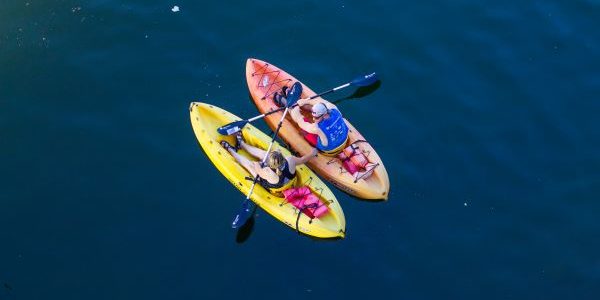
Inflatable Kayak
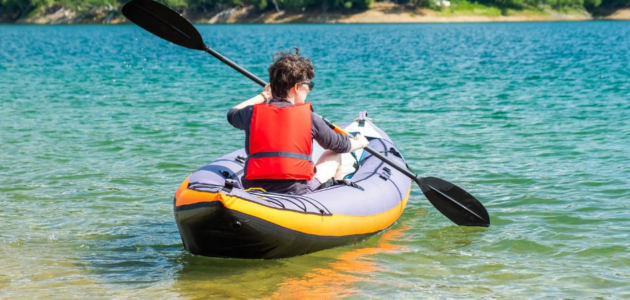
An inflatable recreation kayak is another great option for the casual kayaker who is mainly looking to sight-see or relax on the water. An inflatable kayak will be very easy to store when not in use, especially in colder months, and is easy to transport by yourself and inflate on site. Inflatable kayaks are stable and rugged so you do not need to worry about using it in a calm river, a gentle bay, or a small lake. You can also pack several in your vehicle for a family trip so everyone gets a kayak without having to worry about a large transportation vehicle.
Tandem Kayak
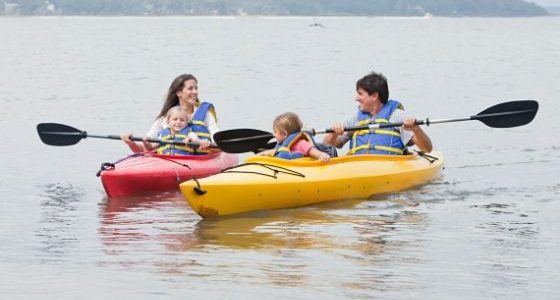
Kayaking for Exercising
Want to take to the water to get in shape? Paddling a kayak can provide great fitness and overall improvements to your health. You will see an increase in arm, shoulder, and back muscles from paddling, leg strength from bracing the kayak to rotate your hips for turns and direction changes, and an improvement to your general health, stamina, and endurance.
There are a few options when selecting a kayak for an exercising habit, but the key is to select a paddle kayak over a pedal kayak. While a pedal kayak will increase your leg endurance, a paddle kayak will work your upper body and more of your body than a pedal design.
General Recreation Kayak
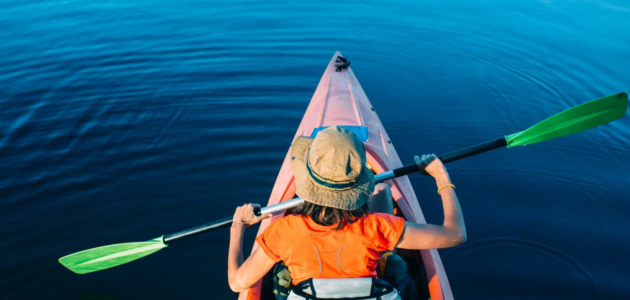
A general recreation model can be a perfect kayak to purchase for exercising. Due to its wide design, it will not move very quickly but will remain very stable. It also requires a bit more effort to maintain a straight path due to its design, so you will consistently be engaged and focused and have a goal to keep it on its path to keep you in shape. These are also easy to load and transport, and if you purchase a sit-on-top model you will have an easier time exiting and entering the kayak.
Inflatable Kayak
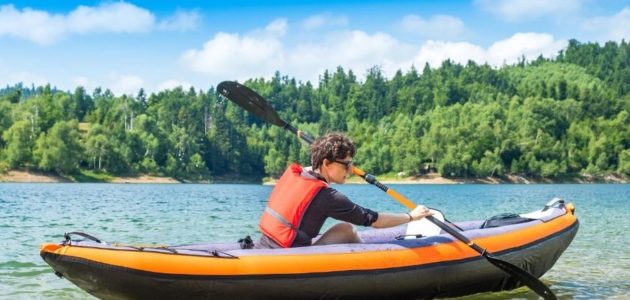
Tandem Kayak
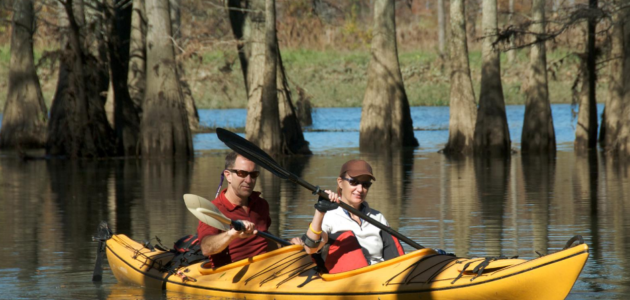
If you don’t exercise solo, a tandem kayak can be a great exercise investment for you and a friend or partner. A tandem kayak not only requires paddling to stay on course and works your muscles through propelling and steering, you also have to coordinate movements with your partner which can add an additional layer of mental and physical involvement. If you and an exercise partner are committed to kayaking together, this can be a great purchase.
Touring Kayak
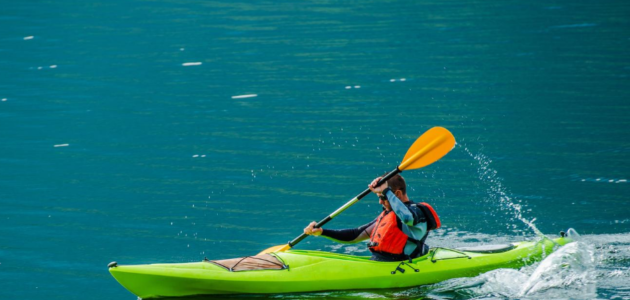
Fishing from a Kayak
If your primary activity out on the water is fishing, then we really only have one suggestion for you — a sit-on-top fishing kayak. The fishing kayak will provide you the stability and extra storage room you need, regardless of fishing on a lake, in the sea, or in a very large calm river. A intentionally designed and modeled fishing kayak will provide the room you need to stand, catch, and handle all of your equipment without additional costly modifications.
We will break down the different types of fishing kayaks you can purchase, and what you should consider overall for each design, but in the end, a fishing kayak will give stability, standing room, mobility, storage, and more no matter which model you select.
Sit-On-Top Fishing Kayak
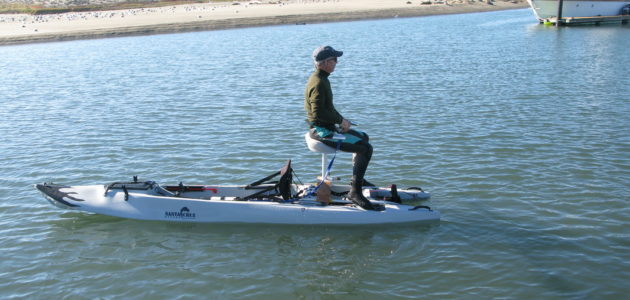
The sit-on-top fishing kayak is the best fishing kayak choice you can make. These models allow for the balance to stand and move about during fishing, so you’re not restricted to your seat or risk imbalance during a hard catch. These kayaks will also have the appropriate storage space for all of your supplies, so you won’t cluttered or searching for room while out on the water.
Pedal Fishing Kayak
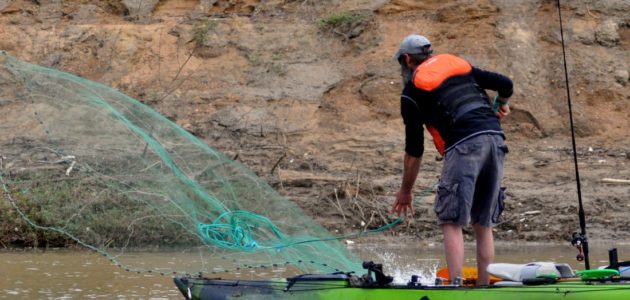
The main consideration when choosing between a pedal model or standard paddling is whether you fish in deeper or shallower waters. A pedal-model will allow you to travel hands-free and move from location to location quicker, but these designs often cannot handle shallower water and are more expensive. You will be making an investment in a trustworthy kayak if you purchase a pedal fishing kayak, and it will be a reliable purchase for an adventure. If you prefer to stay near shore, a paddle model of a fishing kayak will work best over a pedal, because the pedal mechanisms will restrict your depths. Some kayak models, like the Raptor G2, can covert from pedal to paddle with minimal effort.
Modified Gen. Rec, Touring, and Inflatable Kayaks
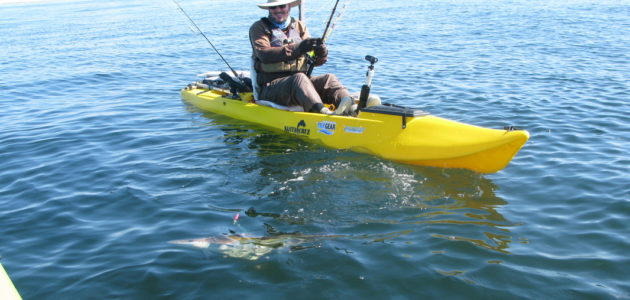
General recreation or touring kayaks may be another possibility if you switch between fishing and casually kayaking, but you will need to purchase additional fishing kayak accessories for these designs to make them more comfortable to fish on, and they still may lack in the additional stability and storage you may desire. However, if you are just beginning to explore fishing while on a kayak, these can be a great way to start to get a feel for what type of fishing kayak you may want to purchase later on.
Taking Multi-Day Trips from the Seat of a Kayak
Touring Kayak
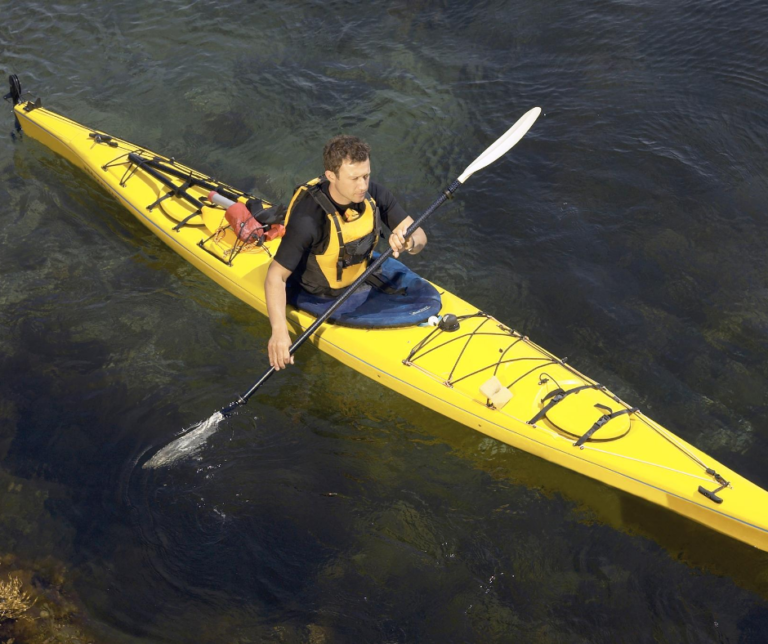
If kayaking is your means to travel between camping locations, or you prefer to take long, multi-day trips, a touring kayak is going to the best solution for you. These models travel faster, have more on-board storage, and are created to go long distances. In contrast, a recreation kayak for longer trips will be more difficult to steer and will take more energy to correct the path consistently.
When browsing for the right touring kayak, consider how far you will want to travel — some models are designed for a weekend, while others can handle 20+ miles for multiple days. Each option will vary with how much storage it has and its overall speed, so consider the length between your two destinations and how quickly you want or need to travel to take your trip safely.
It will be best to discuss with others in the kayaking community the specifics of your trip when making your purchase, especially if traveling a few days by kayak will be new for you. Don’t get out on the water and realize you don’t have room for all of your gear, or your extra-long touring kayak can handle the distance of your trip but not the bends in the river.
Navigating Whitewater
Whitewater Kayak
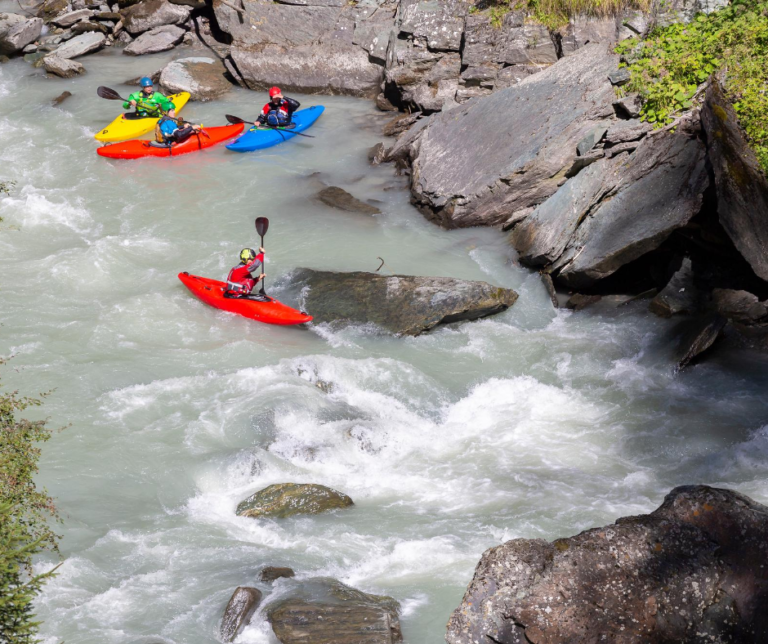
We’ve mentioned a few times in this article, but whitewater kayaking is a specialty kayaking experience that requires specialty kayaks and equipment. We couldn’t break down each whitewater kayak with an efficient summary, but it is wise to consider what you want to do while whitewater kayaking and where.
For example, some whitewater kayaks are designed for flips and tricks, with much shorter bodies. If you intend to journey through whitewater, however, a long whitewater kayak will help you move safely and quickly through currents.
These whitewater models are either much shorter than recreation designs or designed differently than traditional touring kayaks. Do some specific research into these areas and talk to an experienced expert in your area — both to make sure you invest in the proper kayak but also to be sure you are experienced and safety-trained enough to handle those adventures.
Conclusion
Purchasing a new kayak, whether as a novice or an experienced kayaker, is always an exciting process. To get the best bang for your buck, it is important to consider where you want to kayak, what you want to do, and how you want to do it. As your kayak collection grows, changes, and develops to fit your kayaking style, know that you can always reach out to experts for advice, and we hope our reference guide helps you to understand what kayak purchase will give you the most adventure. Go forth and paddle, pedal, and explore via the open water.














erotik
Posted at 23:05h, 14 NovemberThanks for ones marvelous posting! I really enjoyed reading it, you can be a great author. Emmy Howard Zabrine
sikis izle
Posted at 06:23h, 16 NovemberMuchos Gracias for your blog. Thanks Again. Fantastic. Melamie Hugo Erle
슬롯 게임
Posted at 19:50h, 25 NovemberBest view i have ever seen !
erotik izle
Posted at 09:19h, 08 DecemberHard to ignore such an amazing article like this. You really amazed me with your writing talent. Thank for you shared again. Tani Lalo Zorina
erotik
Posted at 11:37h, 09 DecemberEnjoyed examining this, very good stuff, appreciate it. Dalia Solomon Wendeline
casino sitesi
Posted at 05:53h, 15 DecemberI cannot thank you enough for the article post.Really thank you! Keep writing. Andy Boldwyn
Adventurehq
Posted at 09:46h, 23 AprilAmazing blog regarding Kayaking Adventure. there are many items that are required during Kayak’s adventure. For this Check out Adventure HQ website. They provide the best quality Kayaking essentials at a good range.